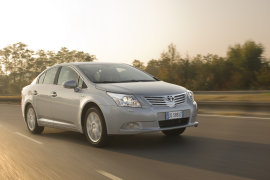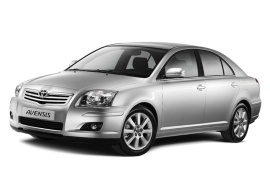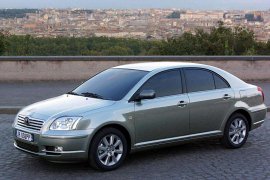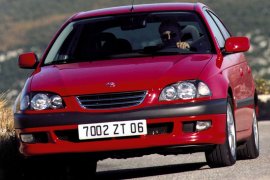TOYOTA Avensis Liftback Models/Series Timeline, Specifications & Photos
First production year: 1997
Engines: Gasoline, Diesel
Body style: Hatchback
The third generation of the Avensis was launched at the 2008 Paris Motor Show and it was presented in three body versions: sedan, liftback, and station-wagon.
The lift-back version was on the market to compete directly with the Ford Mondeo and Opel/Vauxhall Vectra. This type of bodywork allowed a better trunk-space, but it looked more like a sedan than a station-wagon.
The front design was the same for all three variants of the Avensis. The big headlights were extended over the sides, on the fenders. It didn't look too much different than the previous Avensis and, truth be told, the design was not the key element for the largest Toyota sedan in Europe.
The interior design was about the same as the 2007 model, but with some differences in the infotainment and safety systems. The rain and light sensors were available from the mid-trim level. The standard audio system used a 4x40W amplifier and it could read MP3 and WMA files. To enhance the audio quality, a Digital Sound Processor (DSP) and automatic sound leveling was included, adjusting the volume according to the noise level from the vehicle's speed.
A new engine was installed on the 2009 Avensis range. The D-4D 125 was introduced for a better fuel-efficiency. It was mated as standard with a 6-speed manual.
The second-generation Toyota Avensis was launched in 2003 and 2004 was already receiving the title of the European Car of the Year.
In 2007, Toyota introduced a refreshed version of the Avensis, with updates regarding its exterior design and a new engine. Not only the liftback body style was upgraded, but the same also applied to the wagon and the sedan versions of Avensis.
Compared to the sedan, the Liftback offered better access to the trunk with the addition of a hatch. The exterior dimensions remained identical.
Aesthetically, the Toyota Avensis came with a stronger exterior design that featured an all-new front bumper, a more dynamic shape with the hood’s strong vertical lines, a new radiator grille, and completely redesigned headlamps.
For 2007, the new Avensis came with LED turn-signals mounted within the outer door mirrors, adding a more premium feel. The side mirrors were now bigger to improve visibility.
Customers were given the choice of five new paint exterior colors: Ash Grey, Brocade Red, Storm Bronze, Fir Green, and Pacific Blue.
The new diesel unit introduced in 2007 was a 2.0-liter D4D engine that developed 125, this engine offering excellent power and reduced fuel consumption at the same time. Friendlier to the environment than its predecessors, the new powerplant had low CO2 emissions of 146 g/km.
More powerful engines were also available, with the range-topping D-4D 180 that developed 177 hp.
Toyota launched the second generation of the Avensis in 2003 in three body versions: sedan, liftback, and station wagon.
With the second Avensis generation, Toyota entered deeply into the European mid-size car segment. The Japanese carmaker considered that a liftback version should cover the needs for both trunk space and look. Opel and Ford did the same with the Vectra and Mondeo, respectively. The French and Italian carmakers, on the other hand, didn't bother with three shapes.
Toyota designed the Avensis in France, where the Laguna liftback was on the mid-size segment podium. But that didn't impress too many other customers. The big headlights and the tall front fascia, even if it was curved over the hood, it didn't impress too much. Its proportions were well but more bland than bold. Moreover, the car's back was often criticized due to its thick C-pillar, which damaged the rear-quarter visibility.
The cabin, on the other hand, was rightly spaced. It offered enough room for five passengers. Thanks to its split-folding rear bench, the trunk could expand from 510 liters (18 cu-ft) to 1,320 (46.6 cu-ft). But still, the dashboard was not such an attractive element. It was right but bland.
Under the hood, the Avensis was available with a wide choice of engines ranging from a 1.6-liter gasoline unit up to 2.4-liter gasoline. The five-door version was available with the diesel versions from the D-4D engine family, offered in a few power options. The standard transmission was a five-speed manual, and a sequential automatic transmission was available.
Toyota introduced the Avensis lineup in 1997 as a replacement for the Carina and offered it with a choice of three bodyworks, including the Liftback.
The Liftback version was a mix between a station wagon and a sedan. It offered customers the option to load long items. In addition, by folding the rear bench, they could throw more luggage into the trunk. Toyota noticed this type of bodywork on other automakers and provided it.
While the Avensis Liftback shared its front fascia with the rest of the Avensis lineup, it looked different from the B-post rearward. The most noticeable element from its sides was the third row of windows installed behind the rear doors. At the same time, this version of the Avensis sported a sloped tailgate at the back flanked by a pair of tear-shaped taillights mounted on the car's rear corners.
Inside, Toyota understood that it had to provide the Avensis with many standard features if it wanted to make a difference in the market. Moreover, it used high-quality fabrics for the upholstery. The front bucket seats provided enough side bolstering so their occupants wouldn't slide on the Europeans' winding roads. At the same time, the rear split-folding bench was fit for three adults, although the one seated in the middle didn't have too much legroom.
Under the hood, the Japanese carmaker installed a choice of five engines paired with a five-speed manual gearbox. For specific markets and engines, Toyota offered a 4-speed automatic transmission.



